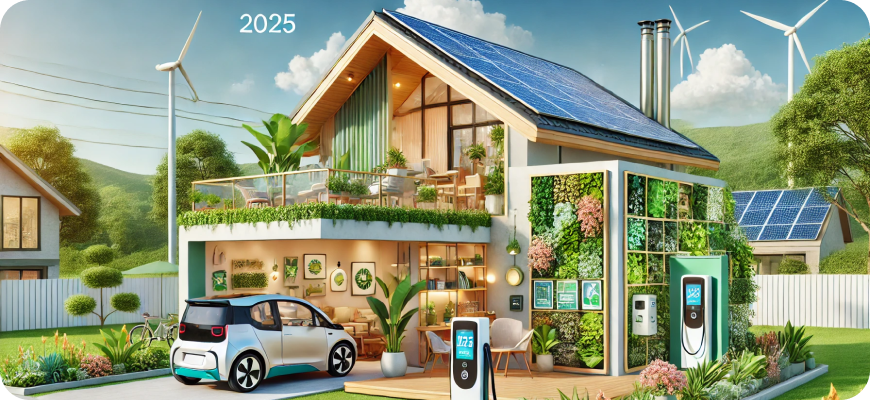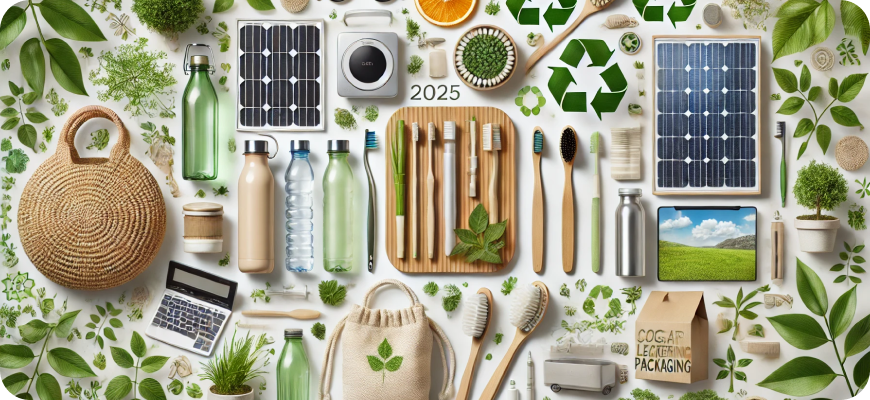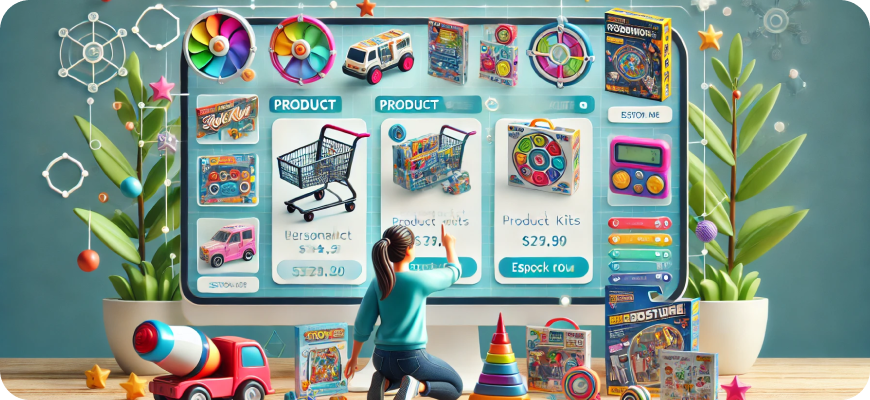Eco-Friendly Products Trends in 2025
As environmental concerns continue to take center stage, 2025 is set to be a pivotal year for eco-friendly products. Consumers across the globe are more committed than ever to reducing their carbon footprints and supporting businesses that prioritize sustainability. This shift in consumer behavior has driven innovation and forced brands to develop products that are both environmentally conscious and effective. In this article, we will explore the top trends in eco-friendly products for 2025, highlighting the emerging technologies, consumer preferences, and market changes shaping the industry.

1. Sustainable Packaging Innovations
One of the leading trends for 2025 is the transformation of packaging. As landfills swell with single-use plastics, companies are actively seeking eco-friendly alternatives to conventional packaging materials.
Key Innovations:
- Biodegradable and Compostable Packaging: Expect to see more brands using materials like cornstarch, mushrooms, and seaweed to create packaging that naturally decomposes.
- Reusable Packaging Solutions: Companies are introducing reusable packaging models, such as stainless steel and glass containers, that can be returned, refilled, and reused.
- Plastic-Free Packaging: Brands are committing to eliminating plastics entirely, turning to alternatives such as paper-based packaging or plant-based polymers.
- Water-Soluble Packaging: Edible and dissolvable films for single-use products are gaining traction, reducing waste without compromising on convenience.
2. Eco-Friendly Fashion and Textiles
The fashion industry is notorious for its environmental impact, but 2025 will see a surge in sustainable practices and products across the sector.
Leading Trends:
- Circular Fashion: Circularity, which emphasizes recycling, repairing, and repurposing clothing, is taking hold. Clothing brands are developing lines specifically designed to be returned, refurbished, and resold.
- Vegan Leather Alternatives: Vegan leathers made from innovative sources like cactus, mushrooms (mycelium), and pineapple fibers are becoming mainstream. These materials replicate the texture and durability of traditional leather without harming animals or the planet.
- Low-Impact Dyeing Techniques: Traditional dyeing processes use vast amounts of water and toxic chemicals. New eco-friendly dyeing techniques, such as plant-based dyes or waterless technologies, significantly reduce environmental harm.
- Second-Hand and Rental Markets: Platforms for resale, rental, and upcycling are growing, shifting consumer habits away from fast fashion to more sustainable options.
3. Plant-Based and Alternative Proteins
Plant-based diets are no longer just a trend—they’re a lifestyle choice for many consumers concerned about health, animal welfare, and environmental sustainability. In 2025, this segment will continue to evolve.
Innovations to Watch:
- Cultivated Meat: Lab-grown meat, produced from animal cells without the need to slaughter livestock, is making headway. Expect to see cultivated meat products available in more markets as regulatory approval expands.
- Plant-Based Seafood: The demand for sustainable seafood alternatives, including plant-based fish and shellfish, is growing rapidly to address overfishing and oceanic pollution.
- Next-Generation Plant Proteins: Advances in texture, taste, and nutritional content are making plant-based products indistinguishable from their traditional meat counterparts.
- Fermented Foods and Proteins: Fermentation technology is driving the creation of protein-rich, environmentally friendly food products with minimal environmental impact.
4. Clean Beauty and Personal Care
Consumers are increasingly mindful of what they put on their skin, leading to a major shift toward eco-friendly and “clean” beauty products.
Noteworthy Trends:
- Waterless Beauty Products: By removing water from formulations, brands can offer more concentrated products, reduce packaging needs, and save water.
- Refillable Containers: Personal care products are being designed for refillable packaging, minimizing single-use waste.
- Ethical Sourcing: Transparency and traceability in ingredient sourcing are becoming crucial. Consumers demand cruelty-free, fair-trade, and sustainably harvested ingredients.
- Biodegradable and Zero-Waste Products: Toothpaste tablets, shampoo bars, and biodegradable sheet masks are examples of beauty products designed to reduce packaging waste and support a zero-waste lifestyle.
5. Renewable Energy and Smart Home Devices
With the focus on reducing carbon emissions, eco-friendly energy solutions and smart home technology are making their way into more households.
Top Innovations:
- Solar-Powered Appliances: Small and large appliances powered by solar energy are becoming more common, offering energy savings and eco-friendly alternatives to traditional power sources.
- Energy-Efficient Smart Devices: Smart thermostats, lighting systems, and energy-monitoring tools optimize energy consumption and lower utility bills, encouraging sustainable living.
- Community-Based Renewable Energy Systems: Shared solar panels and wind energy for neighborhoods, housing developments, and rural areas are emerging, making renewable energy more accessible and affordable.
- Battery Storage Systems: Advanced battery technologies are enabling homeowners to store renewable energy for use during peak hours or when the sun isn’t shining, reducing dependency on traditional grids.
6. Sustainable Cleaning Products
Conventional cleaning products often contain harsh chemicals that can harm both people and the environment. The eco-friendly cleaning industry has responded with safer, greener alternatives.
Emerging Trends:
- Concentrated Cleaners and Tablets: Waterless cleaning tablets and concentrated solutions that users dilute themselves reduce packaging waste and carbon emissions from shipping.
- Plant-Based Formulations: Cleaning products formulated with plant-based ingredients offer effective performance while being biodegradable and non-toxic.
- Compostable Wipes: Biodegradable cleaning wipes are replacing traditional disposable wipes, which often end up in landfills.
- Reusable Cleaning Tools: Microfiber cloths, bamboo scrubbers, and stainless-steel brushes are designed to last longer and reduce single-use waste.
7. Electric Vehicles (EVs) and Green Mobility
As governments push for net-zero emissions and cities invest in green infrastructure, electric vehicles (EVs) and eco-friendly transportation solutions are surging in popularity.
Key Developments:
- Affordable EV Options: Manufacturers are creating more affordable electric cars and SUVs to make green mobility accessible to the masses.
- EV Charging Infrastructure Expansion: Expanded charging networks and ultra-fast chargers are making it easier for consumers to own and operate electric vehicles.
- Electric Micro-Mobility Solutions: Electric scooters, bikes, and mopeds are providing low-emission transportation options for short commutes in urban areas.
- Hydrogen-Powered Vehicles: Hydrogen fuel cell vehicles, which produce only water as a byproduct, are gaining traction as a clean energy alternative.
8. Zero-Waste Lifestyle Products
A zero-waste lifestyle involves minimizing waste by using reusable, compostable, or recyclable products. Consumers embracing this lifestyle are fueling the demand for innovative zero-waste goods.
Popular Products:
- Reusable Coffee Cups and Straws: Durable, reusable products are replacing single-use items in daily routines.
- Bulk and Refill Stores: Dedicated stores allow consumers to purchase bulk goods and refill containers for products like soap, detergents, and pantry staples.
- Plastic-Free Personal Care: Zero-waste alternatives, such as bamboo toothbrushes and metal razors, reduce landfill waste and offer sustainable solutions for everyday use.
- Compost Bins and Kits: Home composting systems are gaining popularity, helping individuals repurpose organic waste and reduce landfill contributions.
9. Eco-Conscious Electronics and Gadgets
The tech industry is adopting sustainability practices in response to growing consumer and regulatory demands for eco-friendly electronics.
Innovations to Note:
- Modular Electronics: Devices designed with modular components allow for easy repairs and upgrades, reducing electronic waste.
- Recycled Materials in Manufacturing: Electronic manufacturers are using recycled plastics, metals, and rare earth elements to produce greener gadgets.
- Energy-Efficient Devices: Eco-friendly electronics consume less energy, reducing the environmental impact of their production and use.
- E-Waste Recycling Programs: Brands are expanding recycling and take-back programs to responsibly manage electronic waste.
10. Smart Agriculture and Eco-Friendly Food Production
Sustainable agriculture practices and eco-friendly food production systems are transforming how we produce and consume food.
Innovations in Agriculture:
- Vertical Farming: By growing food indoors with minimal water and energy, vertical farms reduce resource consumption and provide fresh produce year-round.
- Regenerative Agriculture: This holistic approach emphasizes restoring soil health, sequestering carbon, and increasing biodiversity on farms.
- Precision Farming Technologies: Data-driven tools help farmers optimize crop yields while minimizing inputs like water and fertilizers.
- Sustainable Packaging for Fresh Produce: Compostable produce bags and food-safe coatings that extend shelf life without harming the environment are gaining popularity.

Conclusion
The demand for eco-friendly products in 2025 will be driven by a combination of consumer demand, regulatory changes, and technological innovation. Companies that prioritize sustainability and offer products that are both effective and environmentally friendly will continue to thrive. As consumers, embracing these trends means making more conscious choices that collectively reduce our environmental impact. Together, we can create a more sustainable world, one product at a time.






